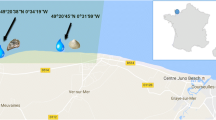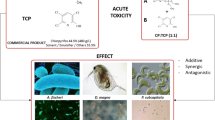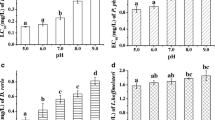Abstract
This work presents the toxicity results of different compounds classified as emerging contaminants on primary producers and primary consumers in the aquatic compartment. The objectives were to (1) obtain acute and chronic toxicity results for algae and Daphnia magna using standardised or currently used tests, (2) study the relationship between the effects on the impaired feeding rate for daphnia and the effects of reproduction and (3) examine the responses on daphnia and algae after binary combinations of environmentally relevant compounds and perfluorooctane sulfonate (PFOS). Toxicity data on personal care products (PCPs), not reported in the scientific literature up to now, are presented. The results confirmed that the Daphnia feeding bioassay can be a sensitive, ecologically relevant endpoint to detect sublethal effects and could complement the information obtained with the reproduction test on Daphnia. The results also suggested that the concomitant occurrence of PFOS and other emerging contaminants in the aquatic compartment could affect the toxicity of some compounds according to their lipophilicity.
Similar content being viewed by others
References
Allen Y, Calow P, Baird DJ (1995) A mechanistic model of contaminant-induced feeding inhibition in Daphnia magna. Environ Contam Toxicol 14:1625–1630
Balk F, Ford RA (1999) Environmental risk assessment for the polycyclic musks, AHTN and HHCB. II. Effect assessment and risk characterization. Toxicol Lett 111:81–94
Barata C, Baird DJ (2000) Determining the ecotoxicological mode of action of toxicants from measurements on individuals: results from short duration chronic tests with Daphnia magna Straus. Aquat Toxicol 48:195–209
Barata C, Baird DJ, Nogueira AJA, Soares AMVM, Riva MC (2006) Toxicity of binary mixtures of metals and pyrethroid insecticides to Daphnia magna Straus. Implications for multi-substance risk assessment. Aquat Toxicol 78:1–14
Barata C, Damasió JB, López M, Kuster M, López de Alda M, Barceló D, Riva MC, Raldúa D (2007) Combined use of biomarkers and in situ bioassays in Daphnia magna to monitor environmental hazards of pesticides in the field. Environ Contam Toxicol 26:370–379
Barata C, Alañón P, Gutiérrez-Alonso S, Riva MC, Fernández C, Tarazona JV (2008) A Daphnia magna feeding bioassay as a cost effective and ecological relevant sublethal toxicity test for environmental risk assessment of toxic effluents. Sci Total Environ 405:78–86
Brausch JM, Rand GM (2011) A review of personal care products in the aquatic environment: environmental concentrations and toxicity. Chemosphere 82:1518–1532
Brooks BW, Foran CM, Richards SM, Weston J, Turner PK, Stanley JK, Solomon KR, Slattery M, La Point TW (2003) Aquatic ecotoxicology of fluoxetine. Toxicol Lett 142:169–183
Campos B, Piña P, Fernández-Sanjuán M, Lacorte S, Barata C (2012) Enhanced offspring production in Daphnia magna clones exposed to serotonin reuptake inhibitors and 4-nonylphenol. Stage-and food-dependent effects. Aquat Toxicol 109:100–110
Carbonell G, Fernández C, Tarazona JV (2010) A cost/effective screening method for assessing the toxicity of nutrient rich effluents to alga. Bull Environ Contam Toxicol 85:72–78
Damasió J, Tauler R, Teixidó E, Rieradevall M, Prat N, Riva MC, Soares AMVM, Barata C (2008) Combined use of Daphnia magna in situ bioassays, biomarkers and biological indices to diagnose and identify environmental pressures on invertebrate communities in two Mediterranean urbanized and industrialized rivers (NE Spain). Aquat Toxicol 87:310–320
De Coen WM, Janssen CR (1997) The use of biomarkers in Daphnia magna toxicity testing. IV. Cellular energy allocation: a new methodology to assess the energy budget of toxicant-stressed Daphnia populations. J Aquat Ecosyst Stress Recover 6:43–55
Dobbins LL, Usenko S, Brain RA, Brooks BW (2009) Probabilistic ecological hazard assessment of parabens using Daphnia magna and Pimephales promelas. Envrion Contam Toxicol 28:2744–2753
Eljarrat E, Marsh G, Labandeira A, Barceló D (2008) Effect of sewage sludges contaminated with polybrominated diphenylethers on agricultural soils. Chemosphere 71:1079–1086
Fent K, Kunz PY, Zenker A, Rapp M (2010) A tentative environmental risk assessment of the UV-filters 3-(4-methylbenzylidene-camphor), 2-ethyl-hexyl-4-trimethoxycinnamate, benzophenone-3, benzophenone-4 and benzylidene camphor. Mar Environ Res 69:S4–S6
Flaherty CM, Dodson SI (2005) Effects of pharmaceuticals on Daphnia survival, growth and reproduction. Chemosphere 61:200–207
Gerhardt A (1996) Behavioural early warning responses to polluted water. Environ Sci Pollut Res 3:63–70
González-Doncel M, García-Mauriño JE, San Segundo L, Beltrán EM, Sastre S, Fernández C (2014) Embryonic exposure of medaka (Oryzias latipes) to propylparaben: effects on early development and post-hatching growth. Environ Pollut 184:360–369
Gutiérrez S, Fernández C, Barata C, Tarazona JV (2009) Forecasting risk along a river basin using a probabilistic and deterministic model for environmental risk assessment of effluents through ecotoxicological evaluation and GIS. Sci Total Environ 408:294–303
Hu WY, Jones PD, DeCoen W, King L, Fraker H, Jones PD, Giesy JP (2003) Alterations in cell membrane properties caused by perfluorinated compounds. Comp Biochem Physiol C: Toxicol Pharmacol 135:77–88
Kaiser D, Sieratowicz A, Zielke H, Oetken M, Hollert H, Oehlmann J (2012) Ecotoxicological effect characterization of widely used organic UV filters. Environ Pollut 163:84–90
Kumar A, Xagoraraki I (2010) Pharmaceutical, personal care products and endocrine-disrupting chemicals in US surface and finished drinking water: a proposed ranking system. Sci Total Environ 408:5972–5989
Kunz PY, Galicia HF, Fent K (2006) Comparison of in vitro and in vivo estrogenic activity of UV filters in fish. Toxicol Sci 90:349–361
LeBlanc GA, Mu X, Rider CV (2000) Embryotoxicity of the alkylphenol degradation product 4-nonylphenol to the crustacean Daphnia magna. Environ Health Perspect 108:1133–1138
Lee H-B, Peart TE, Svodoba ML (2005) Determination of endocrine-disrupting phenols, acidic pharmaceuticals, and personal-care products in sewage by solid-phase extraction and gas chromatography-mass spectrometry. J Chromatogr A 1094:122–129
Liu W, Chen S, Quan X, Jin YH (2008) Toxic effects of perfluorosulfonic and perfluorocarboxylic acids on the membrane system of a freshwater alga measured by flow cytometry. Environ Toxicol Chem 27:1597–1604
Liu W, Zhang YB, Quan X, Jin YH, Chen S (2009) Effect of perfluorooctane sulfonate on toxicity and cell uptake of other compounds with different hydrophobicity in green alga. Chemosphere 75:405–409
Martini F, Fernández C, San Segundo L, Tarazona JV, Pablos MV (2010) Assessment of potential immunotoxic effects caused by cypermethrin, fluoxetione and thiabendazole using heat shock protein 70 and interleukin-1β mRNA expression in the anuran Xenopus laevis. Environ Toxicol Chem 29:2536–2543
McWilliam RA, Baird DJ (2002) Post-exposure feeding depression: a new toxicity endpoint for use in laboratory studies with Daphnia magna. Environ Toxicol Chem 21:1198–1205
Organisation for Economic Co-operation and Development (OECD) (2004) Guideline for testing of chemicals, Daphnia sp. acute immobilization test (Guideline No. 202). OECD, Paris
Organisation for Economic Co-operation and Development (OECD) (2008) Guideline for testing of chemicals, Daphnia magna reproduction test (Guideline No. 211), Organisation for Economic Co-operation and Development (OECD)th edn. OECD, Paris
Organisation for Economic Co-operation and Development (OECD) (2011) Guideline for testing of chemicals, freshwater alga and cyanobacteria growth inhibition test (Guideline No. 201). OECD, Paris
Pablos MV, Fernández C, García-Hortigüela P, Valdovinos C, Tarazona JV (1999) Comparison of different extraction procedures for organic-fraction toxicity testing of urban sewages. Toxicol Environ Chem 70:115–127
Peck AM (2006) Analytical methods for the determination of persistent ingredients of personal care products in environmental matrices. Anal Bioanal Chem 386:907–939
Pieters BJ, Liess M (2006) Maternal nutritional state determines the sensitivity of Daphnia magna offspring to short-term fenvalerate exposure. Aquat Toxicol 76:268–277
Ramos C, de la Torre AI, Tarazona JV, Muñoz MJ (1996) Desarrollo de un ensayo de inhibición de Chlorella vulgaris utilizando un test en microplacas. Rev Toxicol 13:97–100 (in spanish)
Rodea-Palomares I, Leganés F, Rosal R, Fernández-Piñas F (2012) Toxicological interactions of perfluorooctane sulfonic acid (PFOS) and perfluorooctanoic acid (PFOA) with selected pollutants. J Hazard Mater 201–202:209–218
San Segundo L, Martini F, Pablos MV (2013) Gene expression responses for detecting sublethal effects of xenobiotics and whole effluents on a Xenopus laevis embryo assay. Environ Toxicol Chem 32:2018–2025
Schlumpf M, Cotton B, Conscience M, Haller V, Steinmann B, Lichtensteiger W (2001) In vitro and in vivo estrogenicity of UV screens. Environ Health Perspect 109:239–244
Schmitt C, Oetken M, Dittberner O, Wagner M, Oehlmann J (2008) Endocrine modulation and toxic effects of two commonly used UV screens on the aquatic invertebrates Potampyrgus antipodarum and Lumbriculus variegatus. Environ Pollut 152:322–329
Schnell S, Bols NC, Barata C, Porte C (2009) Single and combined toxicity oh pharmaceuticals and personal care products (PPCPs) on the rainbow trout liver cell line RTL-W1. Aquat Toxicol 93:244–252
Sieratowicz A, Kaiser D, Behr M, Oetken M, Oehlmann J (2011) Acute and chronic toxicity of four frequently used UV filter substances for Desmodesmus subspicatus and Daphnia magna. J Environ Sci Health A 46:1311–1319
Wong CS (2006) Environmental fate processes and biochemical transformations of chiral emerging organic pollutants. Anal Bioanal Chem 386:544–558
Yamamoto H, Tamura I, Hirata Y et al (2011) Aquatic toxicity and ecological risk assessment of seven parabens: individual and additive approach. Sci Total Environ 410–411:102–111
Acknowledgments
This work has been funded by Spanish Project CTM-2013-44986-R.
Author information
Authors and Affiliations
Corresponding author
Additional information
Responsible editor: Henner Hollert
Rights and permissions
About this article
Cite this article
Pablos, M.V., García-Hortigüela, P. & Fernández, C. Acute and chronic toxicity of emerging contaminants, alone or in combination, in Chlorella vulgaris and Daphnia magna . Environ Sci Pollut Res 22, 5417–5424 (2015). https://doi.org/10.1007/s11356-015-4119-1
Received:
Accepted:
Published:
Issue Date:
DOI: https://doi.org/10.1007/s11356-015-4119-1




